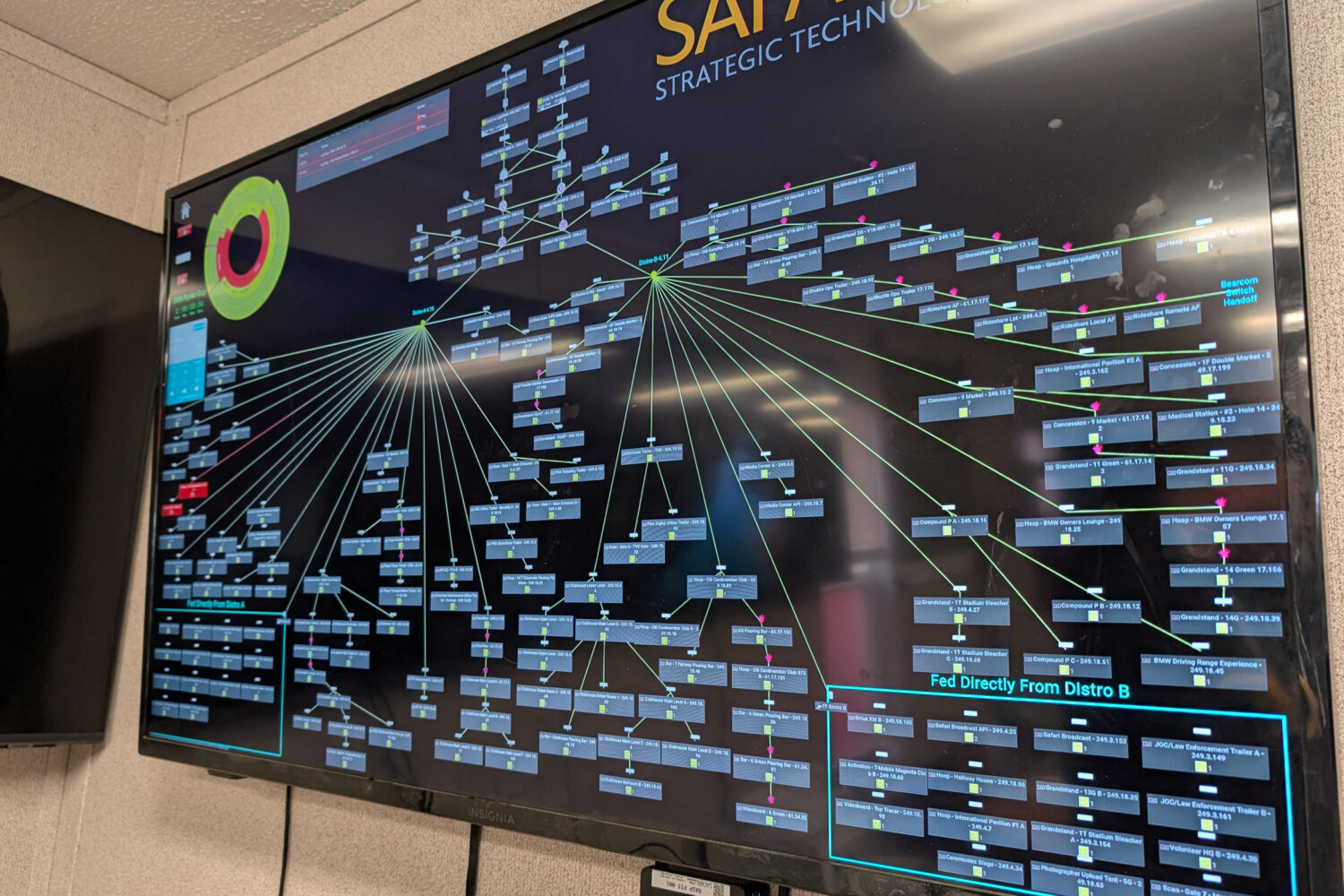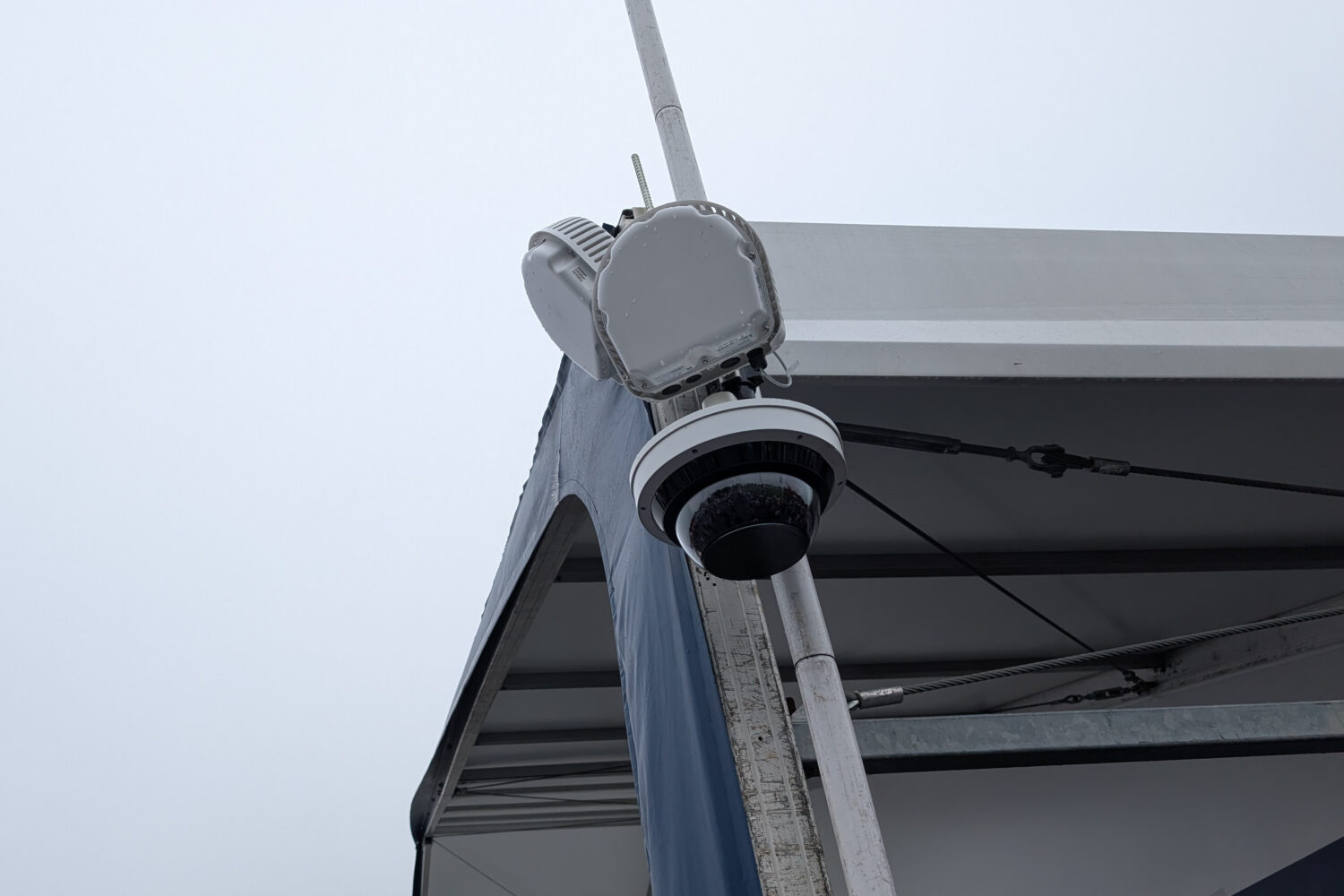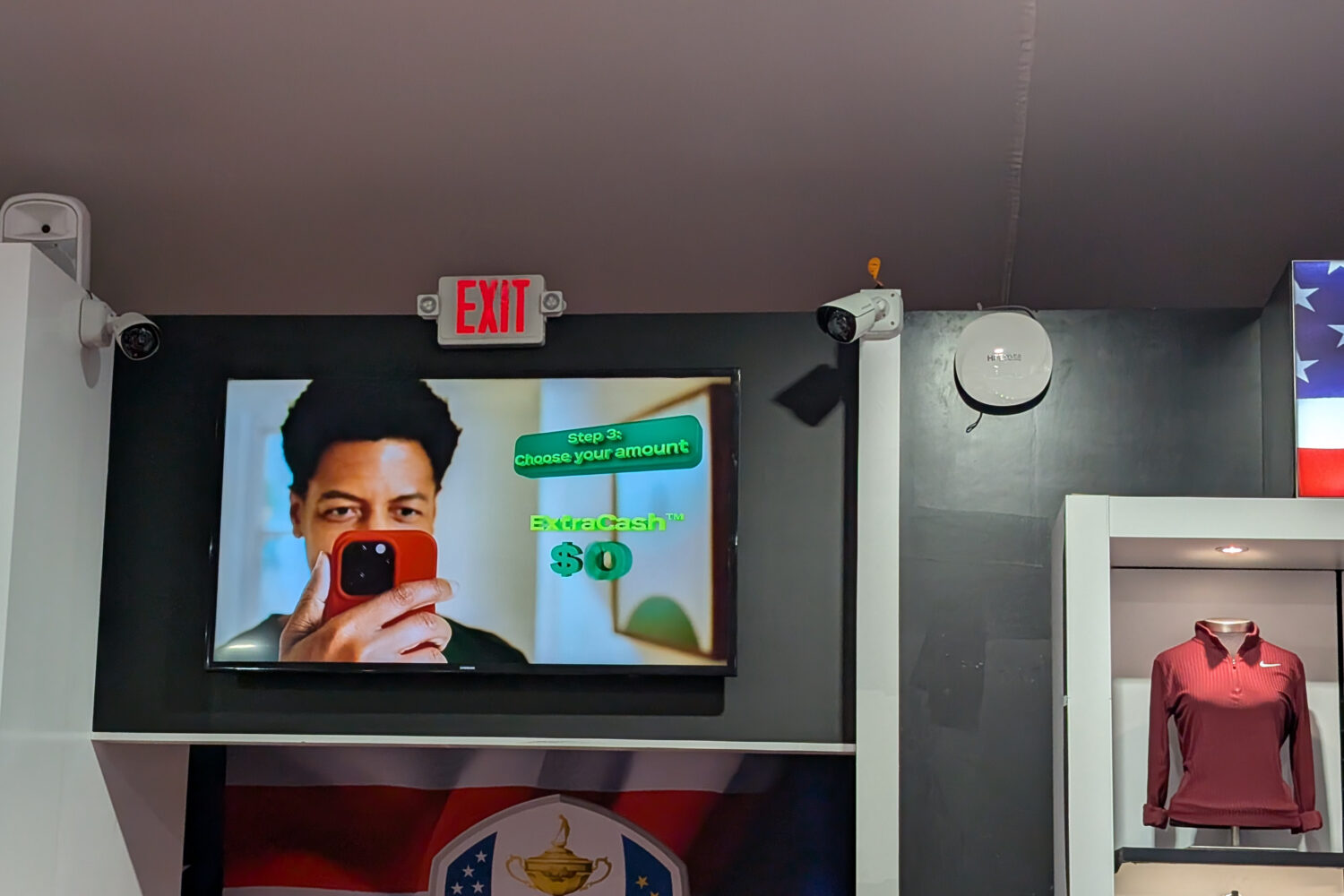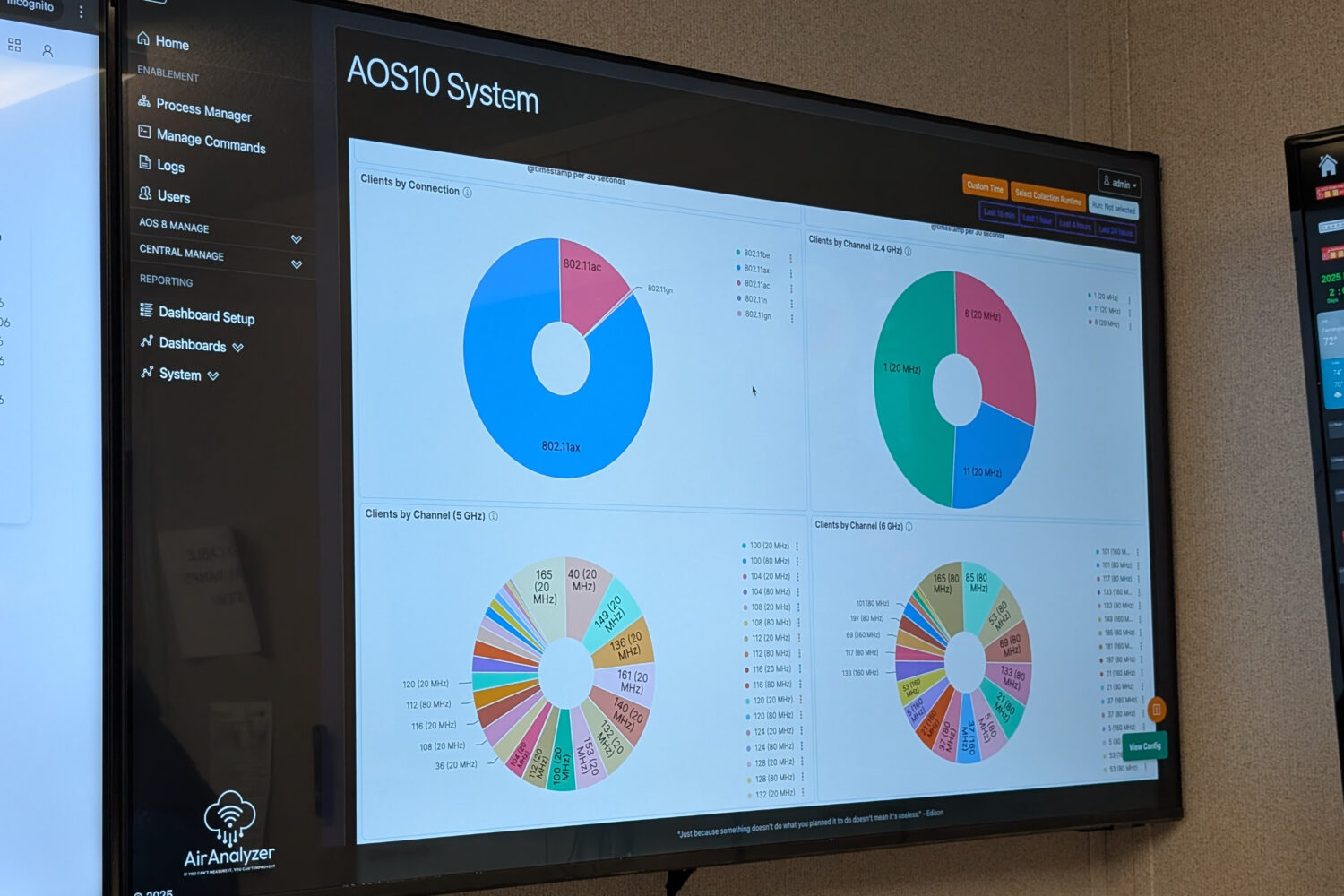The Ryder Cup at Bethpage Black, near New York, was a memorable edition of the biennial golf tournament between players from the United States and Europe. Europe won, President Trump stopped by (and had Air Force One fly over the golf course), and American spectators misbehaved toward the European players. For us, however, it was particularly interesting because HPE invited us to take a look behind the scenes. We saw a very extensive (temporary) network and, for the first time, an example of the new HPE Private Cloud AI stack.
A golf course is not an easy environment in which to install a good network infrastructure. Covering the large distances inherent to this environment mean rolling out a lot of fiber. The same goes for the number of access points. Private 5G further adds to the complexity of the infrastructure.
Bethpage Black is an extremely challenging course for players. A golf tournament that attracts 50,000 visitors per day, as was the case at this Ryder Cup, also means a considerable challenge for HPE.

HPE has had a partnership with the Ryder Cup since 2018 for the competitions in Europe (in Paris in 2018, in Rome in 2023). For the American editions of the Ryder Cup (the last one was in 2021 in Whistling Straits, Wisconsin), Cisco always took care of the network. HPE Aruba Networking has replaced that from this edition onwards, something that James Robertson, Industry Strategy CTO at HPE and main spokesperson during our visit, is keen to emphasize.
“One of the largest temporary networks in the world”
Bethpage Black is big. So big, in fact, that Robertson dares to say that the network HPE Aruba Networking has built there is “probably one of the largest temporary networks in the world, if not the largest.”
Robertson and HPE claim that it covers an area of 1,500 acres (more than 6 square kilometers). Upon closer inspection, this is probably not entirely accurate. 1,500 acres is the area of Bethpage State Park, the name of the entire site. It has five courses. In addition to the black course, there are also yellow, green, red, and blue courses. The tournament will not be played on those other courses. Therefore, there is no need to install a temporary network there.
It may not be six square kilometers, but the temporary infrastructure at Bethpage Black is still impressive. Here is a list of the equipment HPE is using:
- 170 CX switches
- 650 Wi-Fi 6E access points
- 25 UXI sensors
- 3-node private 5G network
- 67 cameras
To connect everything, Safari Solutions, the integrator working with HPE during the Ryder Cup, has installed a temporary fiber optic network. Safari Solutions didn’t put the fiber optic cables into the ground. Rather, they run above ground. These are, of course, reinforced cables that can withstand rough handling. Two cables come out of the temporary control room, one turning left and one turning right. One provides connectivity to one half of the course, the other to the other half.
We heard different stories about issues such as failover and redundancy during our visit. Jeff Weaver, Wireless CTO at HPE, indicated that no redundancy had been built into the fiber optic connections. However, when we asked the person who showed us around the server trailer for further clarification, they indicated that the entire backbone had been laid out in a ring topology. This means that a certain degree of redundancy has been built in after all.
We also see the necessary redundancy in the rest of the infrastructure. The location itself has two 10G WAN fiber optic connections. In addition, there are two identical racks in the server trailer: a Worker rack and a Control rack. So there is also redundancy and failover there.
People in the infrastructure trailer on Bethpage Black manage the entire network infrastructure from HPE Aruba Networking Central. With the exception of the cameras and fiber optic cables, everything comes from HPE’s own factories. The cameras are referred to as ‘AI-enabled’, but when we ask further questions, it turns out that they are fairly standard cameras. The AI component is not in the cameras themselves. They provide the images, after which AI extracts insights and such within the HPE environment.
If you look around Bethpage Black, it is clear that cameras and access points appear in pairs. This is no coincidence. It makes it easier to power everything. In addition, the output from the camera also serves as input for the access point. That is, if it is clear that there are a lot of people from analysis of the camera footage, the access point may need to be scale up its efforts.

Private 5G
Compared to the Ryder Cup in Rome, there have been some necessary changes. For example, Wi-Fi 6E (with the extra 6GHz band) has now been chosen instead of Wi-Fi 6. According to Robertson, this edition of the Ryder Cup was too early for Wi-Fi 7 in terms of the availability of those access points.
Furthermore, 5G also plays a different role. In Rome, a lot of traffic had to go through a local mobile provider because it was not easy to install fiber optics there. This year at Bethpage Black, HPE has set up a real Private 5G network of 3 nodes, something HPE has been able to do since the acquisition of Athonet in 2023. Specifically, this involves the deployment of the BR-150 cellular bridge in combination with the three nodes.

Private 5G is, to a certain extent, an experiment for HPE during the Ryder Cup, Robertson tells us: “Partly it’s an experiment, partly we want to use it to fill last-minute gaps in coverage [of the Wi-Fi, ed.].” In terms of experimentation, he specifically points to gaining insights into coordinating Private 5G (CBRS) frequencies with those of the mobile providers that also offer coverage in the area. But if someone comes along at the last minute and wants to set up a pop-up tent somewhere to sell something, they can do so much faster and easier via Private 5G than via the ‘standard’ network.
UXI sensors
One last component in the list above that we find interesting is the 25 UXI sensors. UXI stands for User Experience Insight. The name says it all: it allows you to gain insights into how well a network is performing. These sensors test the state of the network, both wired and Wi-Fi, as well as the performance of applications. The results of all these tests are sent to the User Experience Insight dashboard in Aruba Central. It is also possible to install a User Experience Insight Agent on an endpoint to run the necessary simulations and tests there.
The UXI sensor must behave like a human, Robertson says. That is, it must be able to simulate things such as latency, SSID problems, access to applications, and social media as people experience them. That is why these sensors are not located in the access points, according to him. They are rarely hung at the right height.
When we point out that this is very similar to what Marvis Minis does in Juniper’s portfolio, Robertson indicates that it is indeed similar, but also largely complementary. Together, they can simulate much more complex situations, such as when the entire audience moves from one hole to another. This gives the whole system even greater predictive capabilities.

 ", boven een vitrine met een kastanjebruin overhemd met ritssluiting.” class=”wp-image-571669″/>
", boven een vitrine met een kastanjebruin overhemd met ritssluiting.” class=”wp-image-571669″/>HPE Private Cloud AI
The network that HPE Aruba Networking set up during the Ryder Cup is quite impressive. It is a “living lab,” as Robertson called it during our visit, so our network experience on site was not entirely flawless. That is not surprising for a temporary network of this size.
We had problems with our network connection quite often. Connecting to Wi-Fi was no problem. The signal was actually strong everywhere. It was mostly a bandwidth issue, as far as we could determine. Switching to the public 5G connection usually resulted in a better connection. So there is still room for improvement. Whether this is something HPE can solve itself with the available tooling is not entirely clear. However, it most likely is not the experience HPE and Safari Solutions strive to deliver.
Also read: With HPE Private Cloud AI you can run all your AI workloads on-premises
In order to achieve the improvements we would like to see, we first need to identify the challenges. That is what this visit is all about. For the first time, HPE has added the necessary AI computing to the infrastructure. Last year, it announced HPE Private Cloud AI (PCAI). Earlier this year, at Discover in Las Vegas, the latest version was unveiled, featuring Nvidia Blackwell GPU. It is now housed in a rack in a trailer on site.
When we say that everything is in a rack, we actually mean that it is in two racks. These are the Worker and Control racks mentioned earlier. So there’s two of everything in two separate racks, from the Gateway, through the access switches and Fortinet FortiGate Firewalls and HPE Aruba Networking ClearPass server for Network Access Control (NAC) to the PCAI node.

According to Scott Wiest, North America Chief Technologist at HPE, implementing PCAI during the Ryder Cup was no easy feat. It took a few months to make the decision, and then he and his team had three weeks to deliver. He believes this clearly demonstrates the added value of a deeply integrated turnkey solution such as PCAI.
Everything comes together in the Operational Intelligence Dashboard
The use of PCAI makes it possible to combine all kinds of data from many different sources. This happens in the Operational Intelligence Dashboard. Of course, this includes telemetry from the network products in the temporary network. But it also includes weather sources, ticketing, the merchandise tent (by far the largest structure on the site), golf cart locations, guest counting, and crowd management.
HPE built the Operational Intelligence Dashboard as part of a larger platform, the Ryder Cup Connected Intelligence Center. HPE Aruba Networking Central is also part of this. A real AI assistant has also been provided. HPE is making this assistant available to Ryder Cup staff who are responsible for ensuring that the event runs smoothly. Of course, staff can ask questions in natural language, in a chatbot. The LLM used by this assistant has been trained on specific documentation, such as Ryder Cup manuals, maps, and other relevant data for the event.
The last two components of the Ryder Cup Connected Intelligence Center are an assistant for easily searching for relevant videos and an HPE AI Developer Portal. The latter, which also includes integration with Dataiku, is particularly interesting to us. Here, it is possible to build AI-related workflows. You can see it as a first glimpse of GreenLake Intelligence. HPE announced this framework for agentic AI earlier this year during HPE Discover.

Living lab in development
Our visit to the Ryder Cup made several things clear. For HPE, one of the most important was that they replaced Cisco at a North American event. This does not mean that all professional golf tournaments there have now dropped Cisco, by the way. PGA of America organizes the Ryder Cup editions in the US. Cisco is still a technology partner of the United States Golf Association (USGA), which organizes the US Open.
More important to us, however, is that HPE should learn a great deal from a project like this. The use of a new generation of Wi-Fi and Private 5G can provide valuable insights into how to configure a temporary network of this size. HPE can learn lessons from this that it can apply elsewhere. The results of the use of PCAI in the wild will undoubtedly be eagerly awaited. In addition, HPE can learn a lot from what happens in terms of workloads. In the case of this Ryder Cup, particularly of AI workloads and the results they deliver in this environment.
Mind you, it’s certainly not all going smoothly yet. The quality of our network connection on the days we were there wasn’t good enough. This needs some more work on the part of HPE and Safari Solutions. HPE has two years to analyze what they can do better next time, in two years time. With the merger of the portfolios of HPE Juniper Networking and HPE Aruba Networking, a whole host of interesting new technological advances are on the horizon. Finally, we are very curious to see the results of the evaluation of the use of PCAI in particular. One thing is certain: AI will play an even greater role at the next Ryder Cup (in Ireland in 2027).

